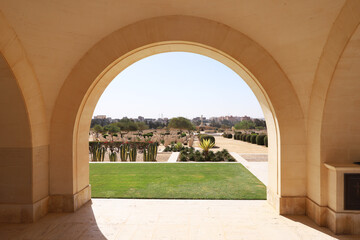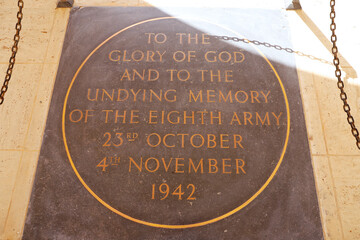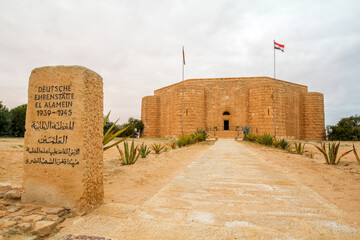El Alamein, a small town located on the Mediterranean coast of Egypt, holds a prominent place in modern history as the site of one of the most decisive battles of World War II. Situated approximately 106 kilometers west of Alexandria and close to the border of Libya, El Alamein was relatively obscure until it became the focal point of fierce military confrontations between the Allied forces and the Axis powers in 1942. The Battle of El Alamein, which unfolded in two major phases—the First Battle of El Alamein in July 1942 and the Second Battle of El Alamein from October to November 1942—marked a turning point in the North African campaign and in the wider context of World War II.
Today, El Alamein is not only a site of historical importance but also a destination that draws visitors interested in military history, paying tribute to the soldiers who fought there, and understanding the broader significance of the battles that took place on its sandy plains. The town also hosts museums, memorials, and cemeteries dedicated to the war, making it a symbol of remembrance and commemoration.
This article delves into the historical background of El Alamein, the details of the crucial battles that took place there, and the top sites for visitors to explore, all of which reflect the region’s enduring legacy
El Alamein’s strategic significance during World War II was due to its geographical location. Situated along Egypt’s narrow coastal strip between the Mediterranean Sea and the Qattara Depression, it was a key point of defense for the Allies. If the Axis forces, under the command of Field Marshal Erwin Rommel—known as the “Desert Fox”—had succeeded in breaking through the Allied lines at El Alamein, they would have gained control of Egypt and potentially the Suez Canal, a critical supply route. Moreover, the Axis forces were poised to access the Middle Eastern oil fields, a resource that would have significantly boosted their war effort.
For months leading up to the battle, Rommel’s Afrika Korps and the British Eighth Army, commanded first by General Claude Auchinleck and later by General Bernard Montgomery, were engaged in a series of skirmishes and maneuvers across North Africa. The fight for dominance in the region centered around controlling vital supply lines, oil resources, and strategic positions that would determine the course of the war in the Mediterranean and Middle East.
The First Battle of El Alamein in July 1942 ended in a stalemate, halting Rommel’s advance into Egypt. However, it was the Second Battle of El Alamein that truly changed the tides of war. From October 23 to November 11, 1942, Montgomery launched a massive offensive, which resulted in a decisive Allied victory. This battle marked the beginning of the Axis retreat from North Africa, culminating in their eventual defeat in Tunisia in 1943



The First Battle of El Alamein (July 1–27, 1942)
By mid-1942, Rommel had driven the British forces eastward across Libya and into Egypt. The Axis forces had gained considerable ground, and Rommel’s next objective was to break through the British defenses at El Alamein, push toward Alexandria, and seize control of the Suez Canal.
The British Eighth Army, however, had entrenched themselves at El Alamein, which presented a natural defensive barrier due to its narrow coastal geography, with the Mediterranean Sea to the north and the Qattara Depression to the south. Rommel launched a series of assaults in early July, but the well-fortified British positions, combined with a shortage of supplies and reinforcements for the Axis forces, prevented a breakthrough.
The First Battle of El Alamein ended in a stalemate, but it was a strategic victory for the Allies because it stopped the Axis advance into Egypt. Both sides suffered heavy casualties, but Rommel’s forces were particularly weakened by a lack of resources, especially fuel, which hindered their ability to continue offensive operations.
By the autumn of 1942, the situation in North Africa had reached a critical point. General Bernard Montgomery had taken command of the British Eighth Army in August and began reorganizing and reinforcing the Allied forces in preparation for a decisive battle. Montgomery, known for his meticulous planning and careful preparation, understood that the upcoming confrontation would be a turning point in the North African campaign.
The Second Battle of El Alamein began on October 23, 1942, with a massive artillery barrage that signaled the start of the Allied offensive. Montgomery’s strategy relied on overwhelming firepower, superior logistics, and well-coordinated infantry and tank movements. Over the next two weeks, the Allies gradually wore down the Axis defenses, breaking through Rommel’s lines and forcing a full retreat.
Rommel, suffering from illness and with his forces critically short of supplies, was unable to mount an effective counterattack. On November 11, 1942, the Axis forces abandoned their positions and began withdrawing westward toward Libya. The Allied victory at El Alamein marked the beginning of the end for Axis ambitions in North Africa. Rommel’s army was pursued across the desert, and by May 1943, the last Axis troops in North Africa had surrendered.
The victory at El Alamein was one of the most significant turning points of World War II. It not only halted the Axis advance in North Africa but also marked the beginning of a series of Allied victories that would eventually lead to the defeat of Nazi Germany and its allies. British Prime Minister Winston Churchill famously remarked after the battle, “Before Alamein, we never had a victory. After Alamein, we never had a defeat.”
El Alamein also holds a place of great importance in the military history of many of the nations involved, including Britain, Australia, New Zealand, South Africa, India, and Greece, all of whom contributed troops to the Allied forces. The battlefields of El Alamein are now preserved as a memorial to the thousands of soldiers who fought and died there.
El Alamein has become a destination for history enthusiasts, particularly those with an interest in military history and World War II. The region is home to several museums, memorials, and cemeteries that pay tribute to the soldiers of both the Allied and Axis forces. These sites provide an opportunity to explore the rich history of the battles and reflect on the human cost of the conflict.
El Alamein is more than just a battlefield—it is a place of remembrance, reflection, and understanding. The battles fought there were pivotal in shaping the outcome of World War II, and the town now stands as a symbol of the sacrifices made by soldiers from all over the world. Through its museums, memorials, and cemeteries, El Alamein continues to honor the memory of those who fought and died in one of the most significant conflicts of the 20th century. As visitors walk through the solemn war cemeteries or explore the sandy battlefield, they are reminded of the courage, resilience, and ultimate cost of war.
©2025 Elite Travel Gate All Rights Reserved